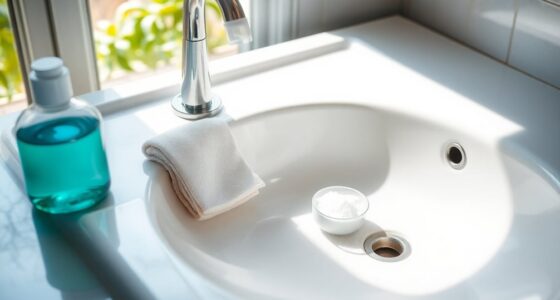To wash dishes in a single sink, start by scraping off food remnants and filling the sink with hot, soapy water. Gather your supplies and create a separate rinsing basin with cool water and vinegar. Wash the least dirty items first, thoroughly scrubbing each piece before rinsing under cool water. Dry dishes upside down in a rack, using a towel for drips. For stubborn stains, soak items in warm soapy water – there are even more tips to make it easier!
Key Takeaways
- Scrape off food remnants and avoid stacking dirty dishes to minimize residue buildup before washing.
- Fill the sink with hot water and dish soap, and keep a separate basin for rinsing with water and vinegar.
- Wash dishes from least dirty to most dirty, starting with glasses and ending with pots and pans to keep water clean.
- Rinse each dish under cool water after washing, using a vinegar solution for added shine and to prevent spots.
- Let dishes dry in a rack with cups and bowls upside down, and change rinse water regularly to maintain cleanliness.
Preparing to Wash Dishes
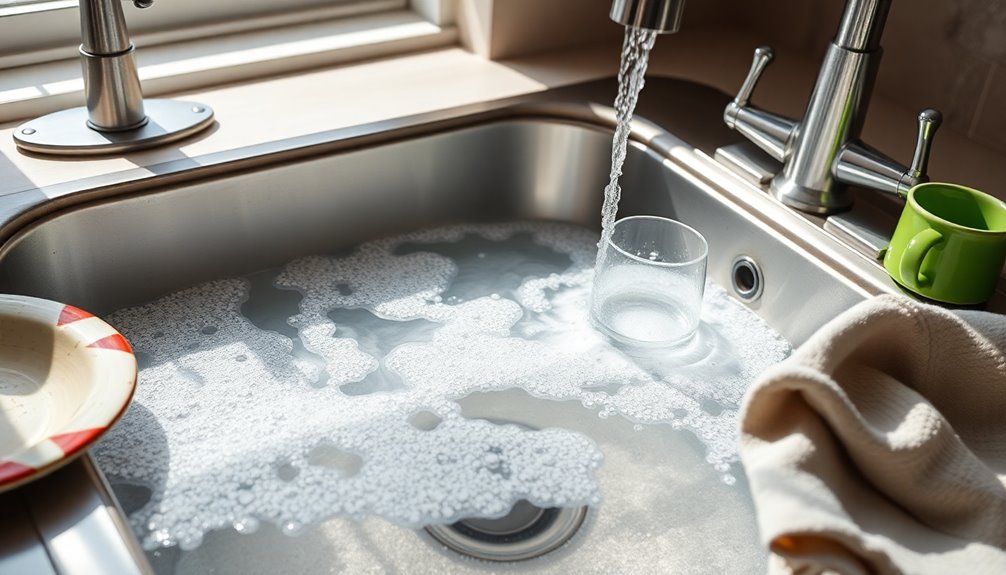
Before you plunge into washing your dishes, it's essential to prep properly to make the process smoother.
Start by scraping off food remnants immediately to prevent them from sticking and becoming harder to clean later. Use a fork or spoon to push food into the sink for disposal, ensuring a cleaner surface while you wash dishes.
Don't let dirty dishes stack up, especially overnight; this leads to stubborn residue and unpleasant odors.
Wearing rubber gloves not only protects your hands from hot water and sharp utensils but also enhances your comfort.
Keep a small trash bin nearby for easy disposal of food scraps, promoting a tidier workspace and setting you up for an efficient dishwashing experience.
Setting Up the Sink
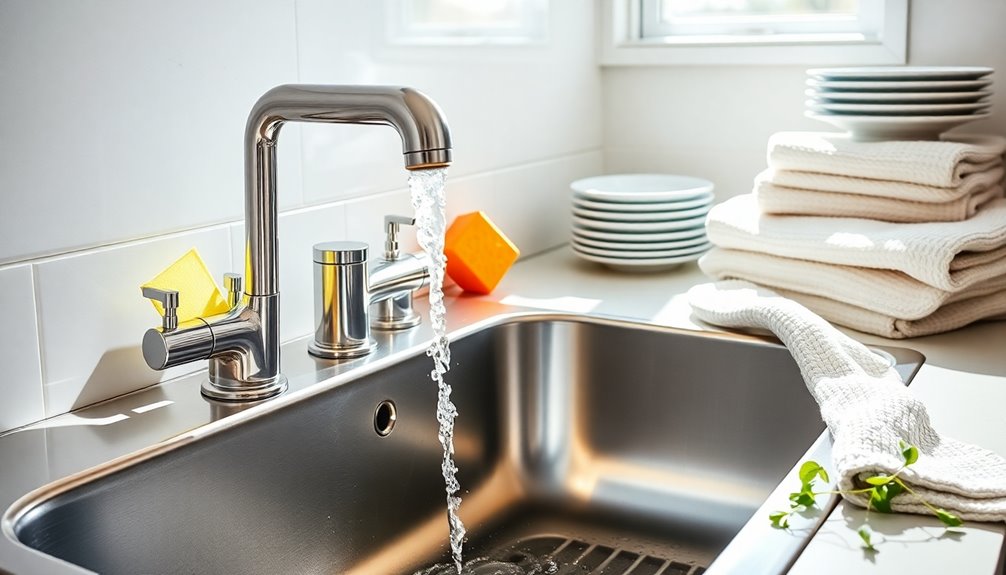
To set up your sink for dishwashing, start by filling it with hot water and adding dish soap until you see plenty of suds.
Next, gather your dishwashing supplies and arrange them for easy access, placing the dirtiest items nearby.
This setup will help you wash more efficiently and keep the process organized.
Filling the Sink Properly
Filling the sink properly is essential for efficient dishwashing. Start by plugging the drain and filling it with hot water, around 120°F, to a level that accommodates the dishes you plan to wash—this prevents overflow.
Add a few pumps of dish soap, ensuring it produces a good amount of suds for effective cleaning.
For hygiene, use a separate basin filled with cool water and a splash of vinegar for rinsing, which helps eliminate soap residue.
Keep an eye on the wash water and refresh it if it gets too dirty or greasy; this enhances cleaning efficiency and prevents cross-contamination.
With the right setup, you're ready to tackle washing dishes effectively.
Organizing Dishwashing Supplies
When you're ready to wash dishes, organizing your supplies can make the process smoother and more efficient.
Start by keeping your dish soap, sponges, brushes, and gloves in a caddy or container near the sink for easy access. Fill one side of the sink with hot, soapy water for washing and set up a separate dishpan for rinsing.
To maximize space, consider using a dish rack that fits over the sink, allowing clean dishes to dry without cluttering your counter. Place a dish towel or drying mat underneath the rack to catch any drips.
Finally, keep a separate container for soaking heavily soiled pots and pans, freeing up sink space and making your dishwashing experience more manageable.
Washing Method
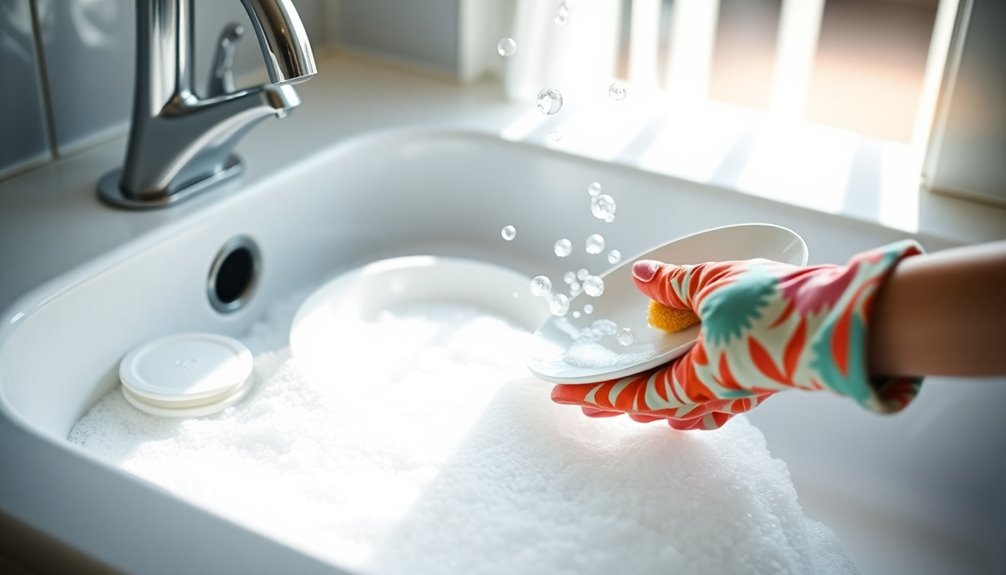
When you wash dishes, start with the least dirty items to keep your wash water clean.
Focus on effective scrubbing techniques to guarantee every dish is thoroughly cleaned, especially the back and bottom where germs hide.
Order of Washing
To wash dishes efficiently, start with the least dirty items first, like glasses and utensils. This helps maintain the cleanliness of your wash water.
Next, tackle plates and bowls, which usually have more food residue. Washing these items before the heavier stuff prevents grease from transferring back to your cleaner dishes.
Finally, save the dirtiest items, like pots and pans, for last. This order of washing not only guarantees effective cleaning but also keeps your water cleaner longer.
As you wash, scrub each item thoroughly with a sponge, paying extra attention to stubborn spots.
Regularly check your wash water for dirtiness and change it when needed, especially after washing greasy items, to keep everything sparkling clean.
Effective Scrubbing Techniques
Start scrubbing your dishes effectively by focusing on the least dirty items first, like glasses and utensils. This keeps your wash water cleaner and prevents spreading grime to cleaner dishes.
Use a high-quality sponge or dish wand with a sturdy handle to reach all surfaces, especially in hard-to-reach areas. For stubborn food residues on serving dishes, soak them in soapy water for a few minutes to loosen debris before scrubbing.
Employ a circular motion while scrubbing to cover more surface area and remove food particles thoroughly. Rinse each dish immediately after scrubbing to avoid soap scum build-up and ascertain no detergent residue remains.
This method guarantees your dishes come out sparkling clean every time.
Rinsing and Drying
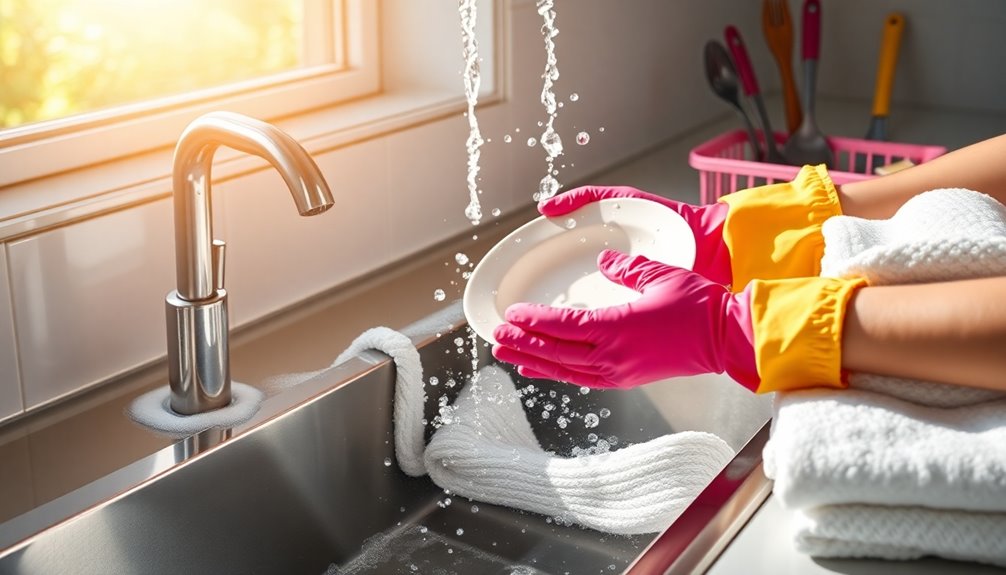
Rinsing and drying your dishes properly is essential for achieving a spotless finish. Start by rinsing each dish thoroughly under cool water to remove soap residue and any food particles.
To enhance shine and prevent water spots, consider mixing one part vinegar with three parts water for a vinegar rinse solution.
After rinsing, place the dishes in a dish rack with cups and bowls upside down for proper drainage. This minimizes the risk of contamination and promotes hygiene.
If the rinsing water becomes dirty or greasy, change it regularly.
Finally, use a dish towel or drying mat under the rack to catch drips, keeping your countertop clean while the dishes dry.
Tackling Tough Stains
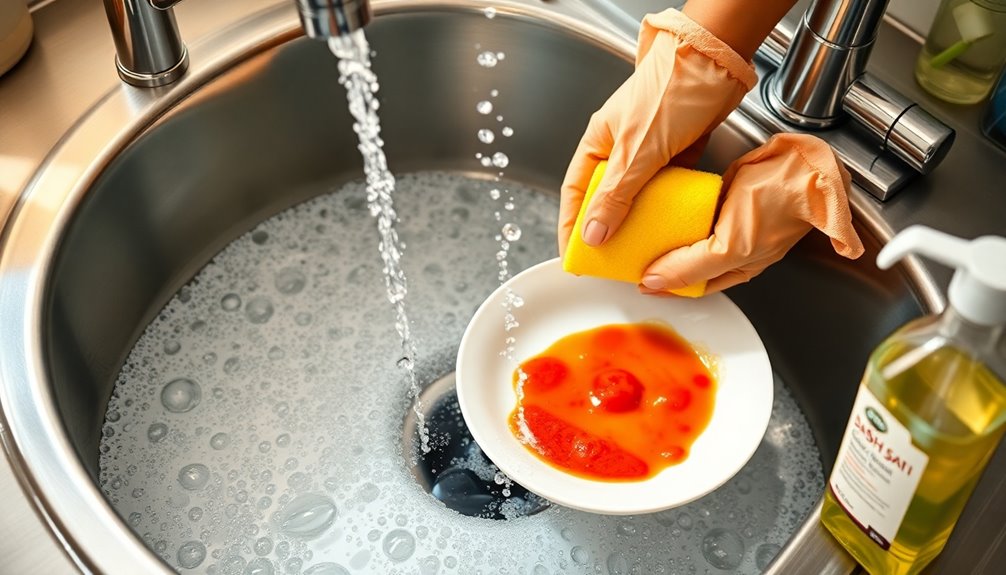
After ensuring your dishes are rinsed and drying properly, it's time to tackle those tough stains that can linger.
For starches and dairy products, start with cold water to prevent clumping and make it easier to remove remaining food.
If you're dealing with baked-on food, soak the dish in warm water mixed with soap and baking soda for a few hours.
Tough stains on pots and pans can benefit from an overnight soak in cold water and salt to loosen burnt food.
For stubborn stains on cookware, use a combination of hot water, soap, and a scrub brush to enhance your cleaning power.
Don't forget to check your soaking solution regularly and refresh it if it becomes dirty or greasy.
Tips for Efficient Dishwashing
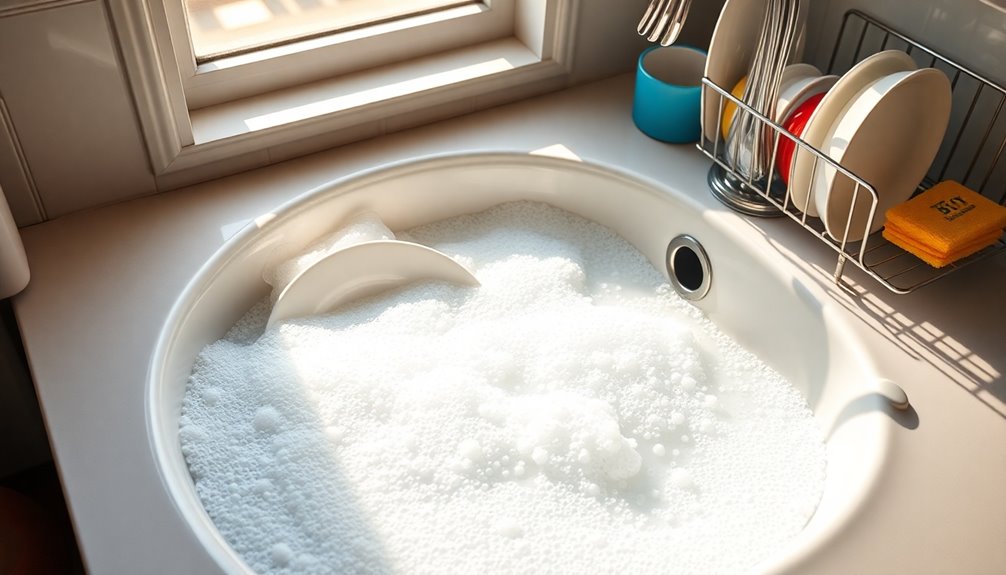
When it comes to efficient dishwashing, establishing a clear routine can make a world of difference. Here are three tips to streamline your process:
- Wash from clean to dirty: Start with glassware and progress to pots and pans. This keeps your wash water cleaner longer.
- Use hot water and soap: Hot water combined with effective dish soap helps break down grease and food residue more effectively.
- Regularly dump out the water: Change your wash water after tackling heavily soiled items to maintain hygiene and prevent grease buildup.
Organizing your dishes by type before you start can also help narrow down your focus, making the task quicker and more efficient.
Happy washing!
Frequently Asked Questions
How to Wash Dishes Without a Double Sink?
Washing dishes without a double sink can be straightforward. Start by filling your sink with hot, soapy water.
Wash the least dirty items first, like glasses, to keep the water cleaner. Use a separate bowl for rinsing to avoid cross-contamination.
Organize your dishes and scrape off any food remnants beforehand for efficiency.
To save space while drying, place a dish rack over the sink or use a drying mat nearby.
Keep it organized!
How Do You Wash Dishes in a Farmhouse Sink?
Washing dishes in a farmhouse sink can feel like a revitalizing dip in a warm stream.
Start by filling the basin with hot, soapy water, making sure it can handle your larger pots. Organize your dishes, tackling the lighter items first. Rinse them under running water or in a separate container.
Remember to switch out your wash water after greasy dishes, keeping everything clean and sparkling. Let your clean dishes dry on a dish rack to save space!
How to Dry Dishes With a Single Sink?
To dry dishes effectively when you've only got a single sink, use a dish rack that fits over the sink. This saves space and allows for efficient drainage.
Position your cups and bowls upside down to prevent water from pooling inside. Place a dish towel or drying mat underneath to catch drips.
Don't stack clean dishes; it promotes air circulation and helps them dry faster, minimizing water spots. Regularly change your drying towel for hygiene.
How to Wash a Single Dish?
When you wash a single dish, start by scraping off any leftover food. This helps prevent sticking.
Next, fill your sink or a bowl with hot, soapy water. Dip the dish in and scrub it with a sponge, paying extra attention to tough stains.
Rinse it thoroughly under cool water to remove any soap.
Finally, place the clean dish upside down in a drying rack to let excess water drain off efficiently.
Conclusion
Now that you've mastered the art of washing dishes in a single sink, picture the warm water cascading over your hands, the gentle suds dancing around the plates. As you rinse, the sparkle of clean dishes shines like morning dew, while the sweet scent of citrus fills the air. With each scrub, you've not just cleaned but transformed the chaos into a tranquil space. Embrace this simple joy—your kitchen is now a canvas of cleanliness and calm.



